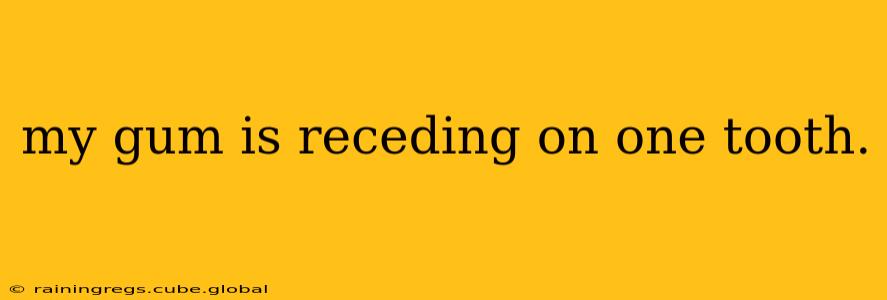My Gum is Receding on One Tooth: Understanding and Addressing Gum Recession
Gum recession, the gradual pulling back of gum tissue from the teeth, is a common dental problem that can affect one or more teeth. While it might seem like a minor issue initially, receding gums can lead to serious dental problems if left untreated. This comprehensive guide will explore the causes, consequences, and treatment options for gum recession, focusing on the specific concern of recession on a single tooth.
What Causes Gum Recession on Just One Tooth?
Gum recession isn't always uniform across all teeth. Several factors can contribute to recession on a single tooth, often in combination:
- Aggressive Brushing: Brushing too hard or using a hard-bristled toothbrush can damage gum tissue over time, leading to recession, particularly on a single tooth if brushing habits are inconsistent or focused on that specific area.
- Gum Disease (Periodontal Disease): This is a major culprit in gum recession. Bacteria build up, causing inflammation and infection that damages the supporting structures of the teeth, leading to gum line degradation. While gum disease usually affects multiple teeth, it can manifest more severely on a single tooth initially.
- Genetics: Some individuals are genetically predisposed to gum recession, regardless of their oral hygiene habits. This predisposition can affect a single tooth more prominently.
- Misaligned Teeth (Malocclusion): Teeth that are crooked or crowded can put extra stress on certain areas of the gums, contributing to recession. A single tooth that's out of alignment may bear the brunt of this pressure.
- Trauma: Injury to the mouth, such as a hard blow to the face, can damage the gum tissue around a specific tooth, leading to recession.
- Tooth Grinding (Bruxism): Chronic grinding or clenching of teeth can exert excessive pressure on the gums, potentially resulting in recession at a specific point of contact.
- Piercings: Oral piercings, particularly if they're positioned near the gums, can contribute to irritation and inflammation, leading to localized gum recession.
Is Receding Gums on One Tooth Serious?
Yes, receding gums on even just one tooth can be serious. The exposed root surface is vulnerable to:
- Sensitivity: The dentin, exposed by receding gums, is significantly more sensitive to temperature changes and acidic foods.
- Cavities: Root surfaces are less protected than enamel, making them more prone to decay.
- Tooth Loss: Severe gum recession weakens the support structure of the tooth, increasing the risk of tooth loss.
How Can I Treat Receding Gums on One Tooth?
Treatment options depend on the severity of the recession and the underlying cause. Your dentist will perform a thorough examination to determine the best course of action. Possible treatments include:
- Improved Oral Hygiene: Your dentist will advise you on proper brushing techniques, recommending a soft-bristled toothbrush and suggesting the use of fluoride toothpaste.
- Scaling and Root Planing: This procedure removes plaque and tartar from the teeth and root surfaces to address gum disease.
- Gum Grafting: This surgical procedure involves transplanting gum tissue from another area of the mouth to cover the exposed root surfaces. There are different types of gum grafts, including free gingival grafts, connective tissue grafts, and pedicle grafts, each with its own advantages and disadvantages. Your dentist will determine the most suitable option based on your individual needs and the extent of gum recession.
- Guided Tissue Regeneration (GTR): This procedure involves placing a membrane over the exposed root surface to encourage the regeneration of gum tissue and bone.
- Enamel Matrix Derivative (EMD): This is a protein-based material that helps stimulate the growth of new gum tissue and bone.
- Deep Cleaning: In cases of severe periodontal disease, a deep cleaning procedure, which involves removing plaque and tartar from below the gum line, may be recommended.
What are the Long-Term Effects of Untreated Receding Gums?
Untreated gum recession can lead to significant long-term consequences, including:
- Increased Tooth Sensitivity: Persistent discomfort and sensitivity to hot, cold, and sweet foods and beverages.
- Tooth Decay: Increased risk of cavities on the exposed root surfaces.
- Tooth Loss: Severe recession can lead to weakening of the tooth's support structure, ultimately resulting in tooth loss.
- Periodontal Abscess: Severe infection of the gums and supporting structures.
- Bone Loss: The loss of bone around the tooth will further compromise its stability and increase the risk of loss.
Can Receding Gums on One Tooth Be Prevented?
Yes, proactive measures can significantly reduce the risk of gum recession:
- Gentle Brushing: Use a soft-bristled toothbrush and brush gently, avoiding aggressive scrubbing.
- Regular Dental Checkups: Regular visits to your dentist for professional cleanings and examinations are crucial for early detection and treatment of gum disease.
- Proper Flossing: Daily flossing removes plaque and food particles from between the teeth and below the gum line.
- Mouthwash: Using a therapeutic mouthwash as directed by your dentist can help control plaque and bacteria.
- Addressing Bruxism: If you grind or clench your teeth, consider using a mouthguard at night.
Early intervention is key to managing gum recession effectively. If you notice receding gums on one or more teeth, schedule an appointment with your dentist as soon as possible. They can diagnose the cause, recommend appropriate treatment, and help prevent further damage. Remember, maintaining good oral hygiene and regular dental checkups are essential for preventing gum recession and maintaining the health of your teeth and gums.
